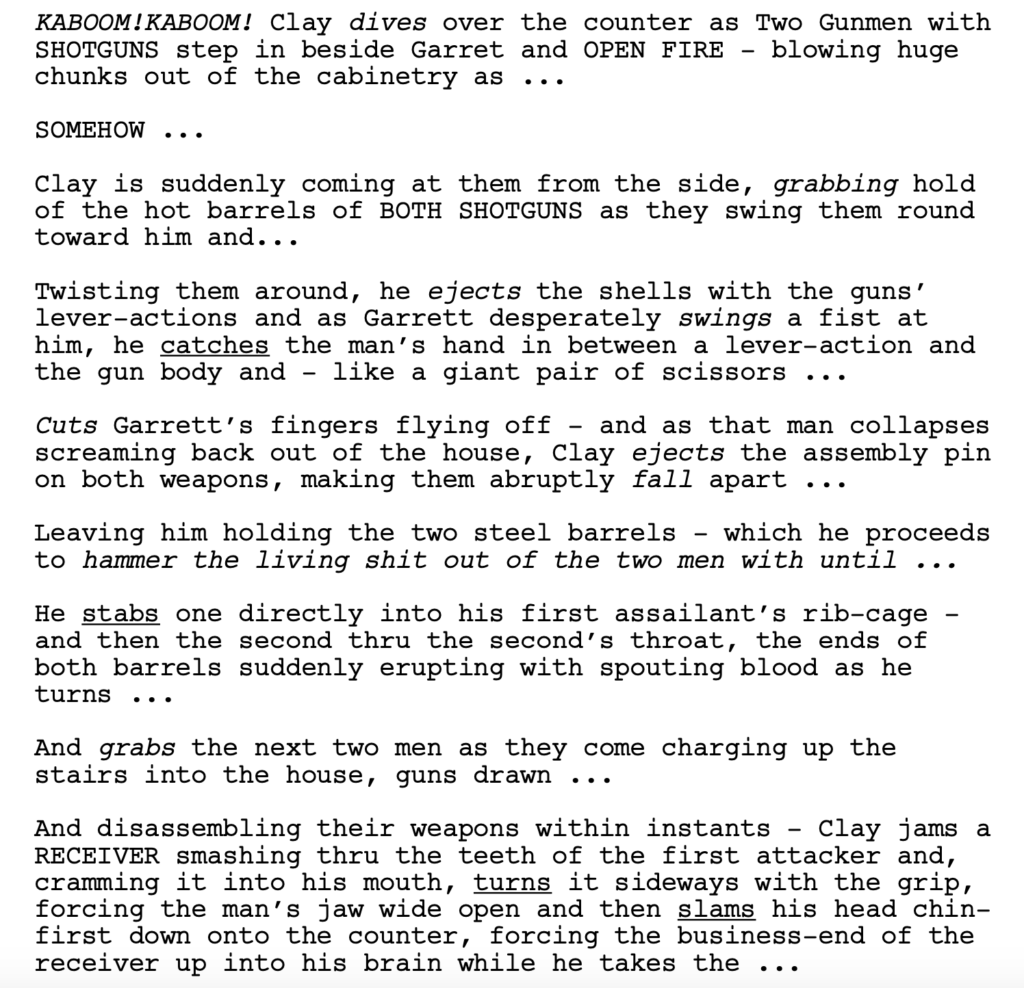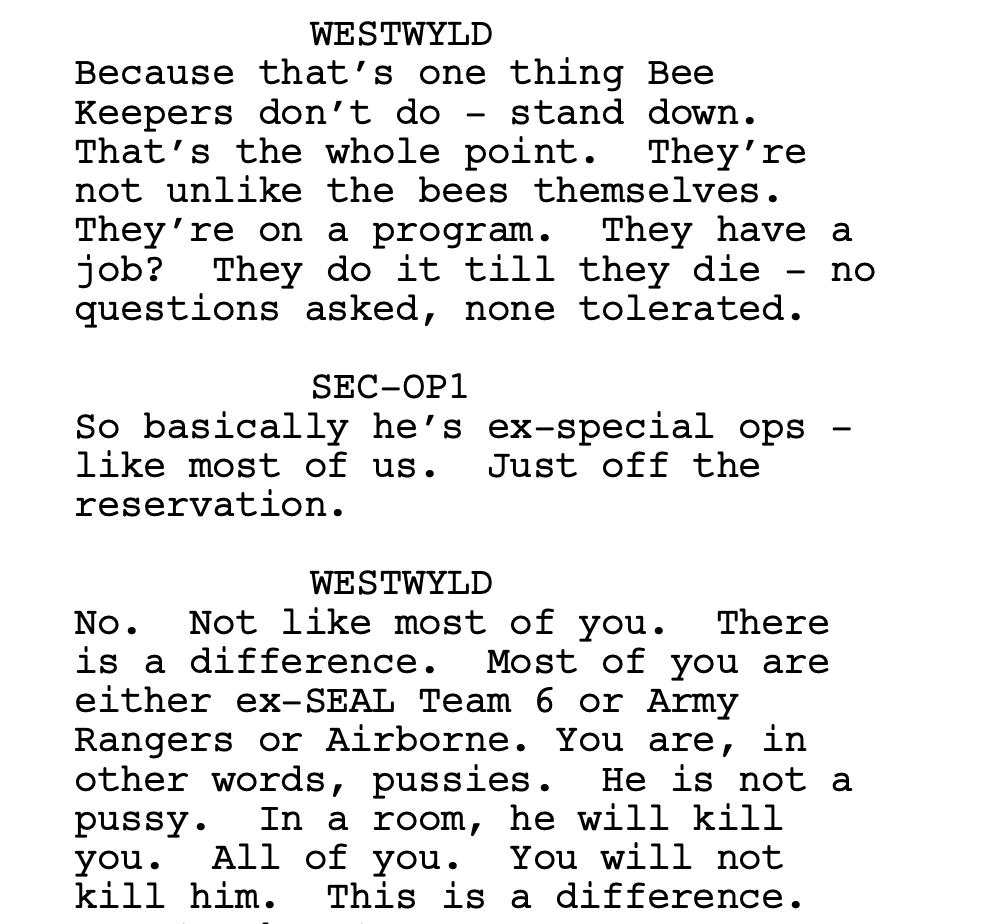Finally! The Bee Keeper script is here!
Genre: Action-Thriller
Premise: When his elderly neighbor is duped out of her entire life savings by online scammers and subsequently commits suicide, a bee keeper goes on a rampage to take the scammers down.
About: Yeah baby! Bzzzbzzzbzzzz! We’ve got a spec script that sold for over a million bucks. We’ve got Jason Statham playing the lead. David Ayer just signed on to direct the film two weeks ago. This is the kind of script writers who want to make a big splash in the business should be writing. Tyler Marceca just made a million dollars for a fun action thriller, Stay Frosty. Shay Hatten blasted onto the screenwriting A-List when he wrote a fun action thriller in Ballerina. This is a very lucrative genre for a screenwriter. And if you want to study someone who does it best, read Kurt Wimmer’s scripts. They’re some of the easiest funnest specs you’ll ever read.
Writer: Kurt Wimmer
Details: 106 pages

I’ve been really excited for this one.
Not only is it written by one of the most successful spec screenwriters of all time, Kurt Wimmer. It’s such a weird subject matter that my curiosity meter is off the charts. An action thriller…. About a bee keeper? Tell me more, please!
An old woman in rural Tennessee named Eloise is on her computer when she gets one of those spam warnings that most people ignore (“Your computer is infected. Call this number to fix it.”). Unfortunately, in an attempt to fix her computer, she calls the number. Within 5 minutes, her entire life savings has been stolen. That night, Eloise commits suicide.
The next day both her FBI agent daughter, Verona, and her reclusive bee keeper neighbor, Adam Clay, who she was friendly with, show up. After they both learn the truth, that a company located in Memphis called “Data Group” did this, Adam shows up at Data Group’s building the next day and burns it down.
Data Group, as it turns out, is a branch of a much larger corporation called Evermore Enterprises, run by the former director of the CIA, Westwyld. And when they find out some dude just burned down their building, they send four heavies to take him out. Except they do not “take him out.” They get taken out in some of the best action-fight writing I’ve seen in years.

Clay then calls Westwyld and tells him he’s coming for him. It is then that Westwyld realizes he is not dealing with an ordinary man. He’s dealing with a “bee keeper.” No, not a bee keeper in the traditional sense. A type of secret agent that is so top secret not even the freaking president knows who he is. These beekepers are part of a larger “hive” who keep the country running by any means possible. I’ll let Westwyld explain…

This forces Westwyld to ask for help from the Secretary of Defense! Who says that the only way to stop a bee keeper is with another bee keeper. Which they reluctantly agree to deploy. And this is where things get crazy, lol! When bee keepers fight each other, they use honey, they use bee puns, they use bee tactics. It is truly a marvel to behold. To say anything more about this script would be to betray the joy of reading it yourself. So find it and read it now! I’m sure someone in the comments can send it to you.
Hoooo-weee! I can’t remember the last time I forgot I was reading something. I totally forgot I was reading a script while reading Bee Keeper.
That’s because Kurt Wimmer is a master at writing spec scripts. And take note of the “spec” part of that declaration. There’s a difference between being great at writing a script and being great at writing a spec script. With a spec script, you have to keep a tighter grip on the reader. If you try to take your time and build something up for 15 pages without anything interesting happening in the meantime, you’ll lose the reader.
Wimmer understands this better than maybe any screenwriter in the business. Not only does he make sure each page keeps you reading. He makes sure before he’s even written a word that the concept and execution are going to create enough situations where he can keep you invested all the way through.
Beginner and even intermediate writers will decide to write a script with no idea if they can keep it entertaining the whole way through. They’re hoping they’ll figure it out “along the way.” Great screenwriters suss this stuff out ahead of time. Wimmer clearly did that here.
I don’t know why I’m surprised but I saw so many things here that were smart. For example, Wimmer does something really complicated in the screenwriting world with effortless ease. He has to make it make sense that Adam Clay will put his entire life on the line to get revenge on these people. And he has to do that through Adam’s connection with Eloise.
The problem is, he has to kill off Eloise quickly because she’s the inciting incident for the whole movie. Her death is what propels him to go on this journey. So he only has a brief amount of time to create a relationship between the two that emotionally resonates.
Complicating this is that you want to start these scripts off BIG. It’s an action-thriller. Starting with a character scene is not the best idea. So that was the puzzle Wimmer was challenged with solving.
What he did was he created this slow opening character scene between Clay and Eloise by inserting a problem – she had a wasps’ nest in her house. This allowed Clay, who’s a bee keeper, to come take care of it for her.
Now one of the tricks you can use to make a slow scene interesting is teaching us something interesting during it. Which is what Clay does. He explains what’s going on with the wasps. He tells us that wasps destroy beehives. Which is why it’s best to terminate them. We show him do some very technical interesting things to destroy the wasps’ nest, allowing us to both learn something cool and establish a relationship between these two so that we understand why he goes after the bad guys later.
On top of all this, we’re learning who our hero is. What he does.
The best scene-writing, especially in the first act, does multiple things at the same time. And Wimmer is doing that on expert-mode here. But he’s not just achieving that. He’s achieving it invisibly. We don’t see any of the mechanisms that are creating this effect because they’re seamless and invisible. That’s great writing.
He also does something really clever with the bad guys. Sometimes we can get lost in trying to create an interesting bad guy. But you can make that job a lot easier on yourself by doing what Wimmer does here – creating a villain with “built-in hate pedigree.” The villain is a scammer (everybody hates scammers) and not only that, but they target the elderly (everybody hates people who take advantage of the elderly).
So before we’ve even met our scammer, we hate him. And that does SO MUCH OF THE WORK FOR YOU when you write the script. Because if we hate the villain, we’ll almost want to keep reading to see them go down MORE than we want to see our hero achieve his goal.
I can’t emphasize this enough. The big secret hack when it comes to writing great screenplays is to make the reader feel EMOTION. Once you have a reader emotionally invested — actually, hold up, let me think about how to phrase this…
You know how when you meet someone who you really really like and want to be with? All you can think about is them and being around them? That’s because you’re emotionally hooked on that person. They’ve triggered you on an emotional level.
It’s the same idea with a screenplay. Just like you can’t convince a person to like you logically, you can’t convince a reader to like a script because you’ve done everything the proper way it’s supposed to be done.
You hook the reader by making them feel something. As strong as you can make them feel it. And we feel it here immediately when we have this nice old lady get taken advantage of by these terrible people. And we’re in! That’s it! We’re in. We want to see that person go down. Which is why this script works so well.
The rest is gravy. It’s a fun ride where this guy tries to kill the bad guys.
The only thing I didn’t like about this script was the idea that there was no recourse for someone illegally jacking into your bank account and transferring all of your money out of it without your permission. Especially when you consider that the woman’s daughter was a federal agent! Talk about kicking the hornet’s nest. The FBI would be able to take this enterprise down within 72 hours.
So I didn’t like that. But crazy enough, the writing was so darn amazing that I didn’t care. It was such a fun exciting and FUNNY ride. I loved this quirky concept of a bee keeper taking the bad guys down. It was so different. And the mastery of Wimmer just made it a dream read. Every screenwriter should read this script to see how to make their own scripts read. It’s truly impressive stuff.
[ ] What the hell did I just read?
[ ] wasn’t for me
[ ] worth the read
[x] impressive
[ ] genius
What I learned: This is a little dialogue trick I’ve learned that always works in scripts like this. The formula goes something like this. Your hero approaches one of their targets and runs into some foot soldiers (guards, heavies, in this case, security) and the foot soldiers ask what your hero is doing here. There’s a tendency to think logically about how your hero will answer that question. They might say, “I have an appointment here and I’m late.” Maybe he tricks them by calling a fake number and letting them talk to the person to “confirm” that he indeed has an appointment. But where’s the fun in that? Instead, when Adam Clay goes to the Data Group building and encounters security outside and they suspiciously ask him what he’s doing here, he responds, “If this is Data Group – the call center – I’m going inside. I’m going to burn it down.” In other words, have your hero say EXACTLY what he’s going to do. You can do this anywhere. If you’re writing a movie in the 1700s and a William Wallace like character walks up to the castle and the guards say, “What do you want?” “I’m planning on walking into your castle here, heading up to the king’s throne room, and gut him before cutting off his head and tossing it out the window.” I’m telling you, it works pretty much every time.

